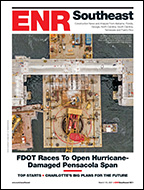The contractor got access to the elevator in eight days. The elevator can store 6.5 billion bushels and load 110-car trains at 80,000 bushels per hour, Kaaz said.
The two highway closures are part of the 70 miles closed in Missouri, 77 miles in Iowa and seven miles in Nebraska—the states with the heaviest road damage during the massive summer-long flooding, according to the state DOTs. City and county roads were not tracked.
After sitting underwater—as little as a few inches to as much as a few feet— for as long as 3½ months, the roads required a variety of work, from debris and silt removal to major reconstruction, according to Dena Gray-Fisher, Iowa DOT spokeswoman.
Patch and Fill
In Missouri, besides the work on U.S. Highway 136, crews placed aggregate fill in roadbed holes up to 60 ft deep and 700 ft long, put aggregate fill in downstream shoulder scour holes, repaired or replaced pavement, patched delaminated asphalt and reinforced spill fills, said Hailey.
"Our roads that were underwater mainly needed clearing, guardrail repairs, patching … and lots of riprap," said Mary Jo Oie, spokeswoman for the Nebraska Dept. of Roads.
Costs are still coming in, with at least $35 million toted up in the three states and another $4 million already planned for Missouri next spring, when pavers can return to work.
DOT crews handled some of the work; bids were let on the rest. But it has not been a non-competitive windfall for contractors. The DOTs "go with whoever the low bidder is" and some in-state companies are getting some of the work, said Doug Smith, president of the Missouri Associated General Contractors.
One plus from the flooding is that "it has introduced projects in a part of the state that wouldn't have happened otherwise," Doug Smith said. Andy Warren, vice president for operations at Iowa AGC, said some in-state firms have gotten work on emergency lettings.
Curt Smith, executive director for Nebraska AGC, said most of the work there involves cleanup, sand removal and sandbags, while Dan Ramlow, executive vice president of the Kansas Contactors Association, a part of AGC, said there was little flood-related work in Kansas.





Post a comment to this article
Report Abusive Comment